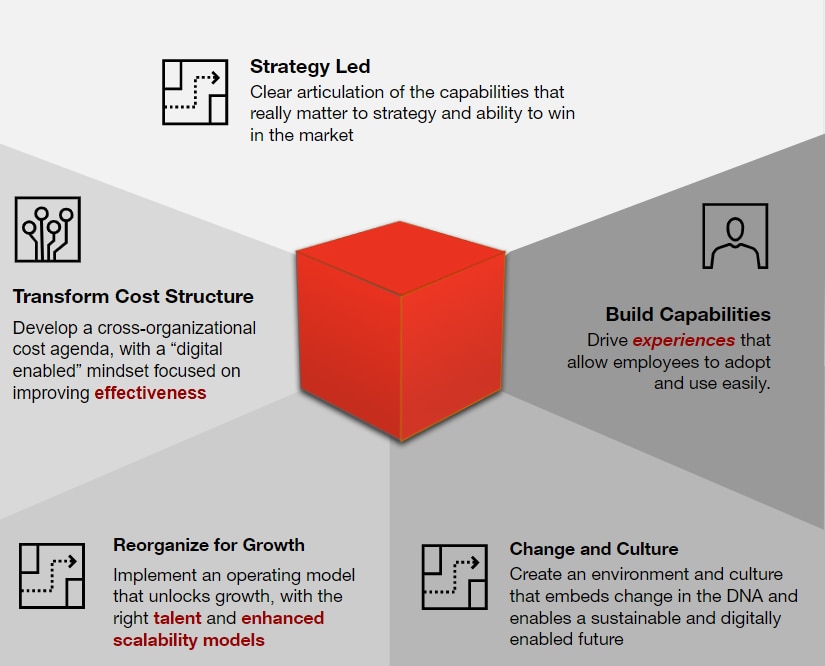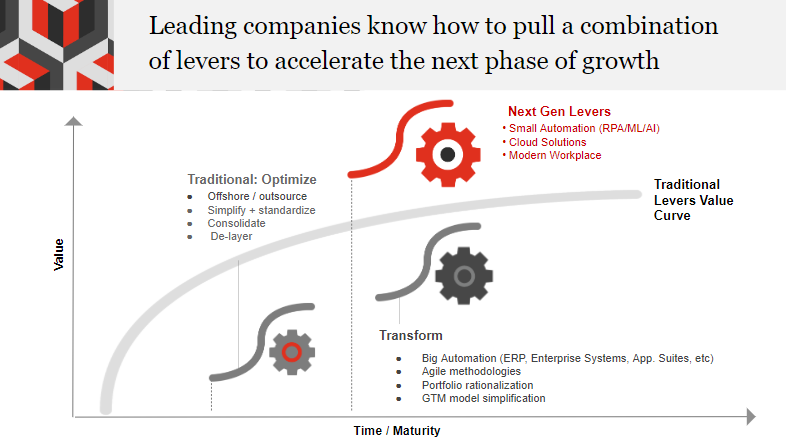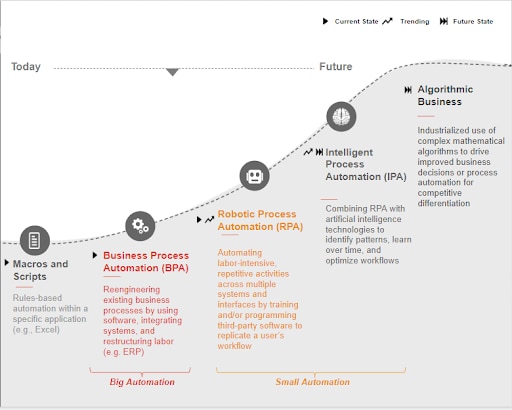Automating for growth
September 27, 2019
This summer, in our Automating for Growth webcast, we shared how automation can be used not only to drive productivity improvements, but also to drive growth. As disruptive forces and performance impact every company in every industry, companies need to reassess what, where and how work gets done in the future to win in the new environment. We call this becoming Fit for Growth and automation is an enabler.
To recap,
- Automation is being used to dynamically drive strategy
- 1+1=3 when it comes to applying digital levers to your transformation journey
- To get the most value from automation, you need to go big + small and you can use small automation to de-risk big automation
Automation is being used to dynamically drive strategy
We are living in a period of significant disruption, and every company in every industry is experiencing it. To date, many firms have tried to tackle these challenges using big automation alone but the promised labor productivity has not been achieved and a different approach is needed to grow. As companies think about automation, there are a myriad of technology options and evolving capabilities from providers and evaluating choices requires a segmented model for decision making. According to a recent study conducted by PwC and Brunswick Group, of the 775 C-level execs surveyed, 70% of them said they are using automation and AI to find ways to improve their businesses by making their operations smarter. Companies are leveraging new digital levers to redefine their strategy and adapt to disruptive forces that are changing our environment.
In this new environment, we cannot rely on the “traditional” methods to define our strategy and evaluate our investment decisions. These methods often relied on extensive management overhead, were too far removed from the areas where benefits accrue, and did not incorporate the requisite skills and knowledge.
The future will be defined by an approach which balances citizen-led activities with center-led support that focuses on building capabilities for long-term growth. The citizen-led component empowers the organization to drive the solutions and the central function takes on an expertise role in guiding capability development and focusing on a set of capabilities that makes a difference. The right balance of citizen-led and center-led will allow you to achieve a dynamic strategy that embeds resilience, is automated to drive continuous refinement to combat uncertainty and a changing market.
1+1=3 when it comes to applying digital levers to your transformation journey
Another key tenet of being fit for growth is to develop a cross-organizational cost agenda, with a “digital enabled” mindset focused on improving effectiveness. Previously when we spoke about aligning costs to strategy, organizations had access to a few key levers:: offshoring / outsourcing, process improvement, consolidation and delayering the organization, big automation (ERP, Enterprise Systems, App. Suites, etc), agile methodologies, portfolio rationalization, and GTM model simplification.
Today, many organizations are in their 2nd or 3rd generation of cost optimization, and have reached the maximum of what these levers can offer. To unlock a different level of potential, both in terms of total savings and time to value, a more digital approach is required, one that taps into next-generation levers such assmall automation (RPA/ML/AI).
As an example, PwC leveraged digital levers to help a financial services company solve reporting pain points and addressed three stages of the process - data prep, data modeling, and reporting - in parallel. Changing core systems and creating APIs or microservices was not an option due to roadmap, bandwidth, and timelines. The solution involved using RPA in combination with the existing OCR tool to automate the data prep process, using a combination of RPA and Machine Learning to reduce the time spent on modeling and generating reports by half and also moved some dynamic reporting to more of a self-serve model. By levering new digital levels, the client created 50% in capacity savings that was invested back in the business to focus on more innovation and improving client experience.
By combining task mechanization automation which yield quick results with decision automation, transformative results could be achieved. Applying digital + traditional levers provided outsized savings potential, or more simply put 1+1=3 in this case.
To get the most value from automation, you need to go big + small and you can use small automation to de-risk big automation
Small automation can be used to augment big automation to increase and accelerate value to an organization. Small automation digital levers, such as RPA, OCR, ML can mitigate the implementation risk of Big Automation as small automation typically has shorter time to value and supports higher degrees of automation. Small automation is tolerant of non-standard processes, capable of managing complexities, effectively operates subscale and can be deployed in quick sprint models. Small automation allows for faster adoption cycles and the opportunity to fail fast, and test various initiatives before moving from pilot to scale.
An organization’s automation capability typically rests on a combination of your core platforms and custom solutions. As capabilities of the core systems evolve, automation will be increasingly built in and where the core systems don’t evolve technologies like RPA and BPM help create efficiency.
Additional technologies can help move from automation of repetitive/repeatable tasks to processes that involve decision making, adjudication, and/or exception handling.
For example, a high tech, chip manufacturing company was trying to modernize their supply chain. Digital levers, such as small automation, helped them create more intelligence in the supply chain, create differentiators that their competition couldn’t easily replicate, and de-risk modernization effort by not exclusively relying on ERP. Part of de-risking was pulling forward those capabilities that could be enabled by machine algorithms — like a smarter forecast.
What’s Next?
So where do you go from here? If you are similar to the participants on our webcast, then there is a >50% chance that your company is only leveraging traditional levers or big automation only to drive cost savings.
The blueprint to change this is fairly simple and can be encapsulated into four key learnings from our client experience:
- Invest in capabilities vs. initiatives: This builds the critical organizational “muscle” needed for long-term growth versus short-term benefit
- Integrate Big and Small Automation: Most organizations need both, and you can accelerate value delivery and de-risk your transformation journey by strategically introducing small automation
- Balance innovation and fast adoption cycles: You must be able to quickly pivot from pilot to scaling. In other words, fail fast, pick the initiatives that balance short and long term value, and then ruthlessly execute
- Focus on decision automation vs. task level mechanization: Focusing on task mechanization will yield quick results, but only decision automation can achieve truly transformative results
In a business environment where growth is key and disruption is constant, you need a dynamic strategy to see you through. Going forward this will increasingly rely on automation, both big and small, and the results will be transformative. As a leader and a decision maker in your organization the best question you can be asking yourself is what are you doing to unlock the benefits of automation and how quickly can you build the capabilities necessary?
Contact us




Contact us






